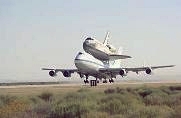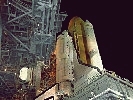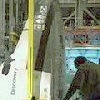- text as of last publication -
 |
| shuttle Discovery taking off on top its modified Boeing 747 Shuttle Carrier Aircraft from Barksdale AFB, La. on Aug. 19th, 2005. NASA photo by Lori Losey |
![]() Special Landing!
Special Landing!
See our page on how a Space Shuttle is coming back from space
See this fine special page of the step-by-step landing of the Space Shuttle from the orbit to the runway!
![]() The Question Of the Insulating Foam. Space and Politics
The Question Of the Insulating Foam. Space and Politics
Despite the apparent success of having had the Space Shuttle returning to flight, the STS-114 mission was marred by the recurrent question of the debris falling out from the External Tank (ET). Although most of such "debris events" did cause less damage than is usually tolerated during any Shuttle's mission, a spacewalk had to be performed in orbit to remove protruding heat shield gap fillers on the underside of the Shuttle's nose
Such facts are showing that the heralded changes at NASA did not actually occur. Following the Columbia accident, the CAIB report had recommended a series of technical and cultural changes at NASA. Well! The ET foam question is still pending
So what? This mission is showing that the only way to put an end to a decade of ill-governance does not reside into patchy-qualmy solutions, but in a real rupture like the one exposed in the "Vision for Exploration" by President Bush in Jan. 2004. The only question is: how this will translate into NASA's daily practice?
![]() Operations Gallery
Operations Gallery
(note that none of these pictures are thumbnails; the gallery is in this format only)
 |  | click to the entire gallery | |
| first stay of shuttle Discovery at launch pad 39B. picture NASA/KSC | shuttle Discovery had to be rolled back to the VAB for mating to a new External Tank. picture NASA/KSC | ||
![]() Mission Timeline
Mission Timeline
see the detailed mission's timeline
The Return to Flight Mission, STS-114, is bound to the International Space Station (ISS) where it will test the new Shuttle's procedures and carry cargo, spare parts, and parts to the orbiting outpost
The Shuttle program has been halted since February 2003, following the dramatic accident of shuttle Columbia during its journey back Earth. No new flight was to take place before that recommendations concerning the NASA safety culture and new Shuttle's technical requirements, as edicted by an investigation board, be implemented. The STS-114 mission is the "Return to Flight Mission", that is the first flight of the Shuttle after the loss of shuttle Columbia. The importance that the requirements of the investigation board be met has led the launch window of the STS-114 flight to be postponed as the shuttle had already been moved to the launch pad. Due to further worries about possible debris coming out from the insulating system of the External Tank (ET), shuttle Discovery was moved back to the Vehicle Assembly Building ( VAB) in Kennedy Space Center, where it was re-mated to a new External Tank. As it's now fitted, shuttle Discovery, which moved back to launch pad 39B, is now ready for launch
->The Crew
It's a woman, Eileen Collins, who will be the commander of shuttle Discovery's crew of 6. Inspired young by a desire to fly, she passed her pilot license, then graduated in the U.S. Air Force. With a bachelor's degree and two masters, she was eventually selected by NASA to join the Astronaut Corps in 1990. Eileen Collins is now a veteran of three space flights, one of them already as mission's commander, and another as the mission's pilot (for the first flight of the joint Russian-American Shuttle-Mir program). Another women, Wendy Lawrence, is part of the mission, as James Kelly is the mission's pilot (PLT). The mission specialists (MS1, MS2, etc) are Stephen Robinson, Andrew Thomas, and Charles Camarda, with are Soichi Noguchi as the payload commander. Wendy Lawrence is a mission specialist too, as Noguchi is from the Japan Aerospace Exploration Agency (JAXA). Commander Eileen Collins has logged more than 6,280 hours aboard 30 different types of aircraft. 537 of these hours have been logged in space!
 |
| launch pad 39B, KSC. picture NASA |
for more, see the official Shuttle page at NASA
Website Manager: G. Guichard, site 'Amateur Astronomy,' http://stars5.6te.net. Page Editor: G. Guichard. last edited: 12/28/2010. contact us at ggwebsites@outlook.com